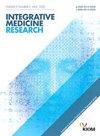Integrative medicine and perinatal outcomes among women giving birth: A national population-based study in South Korea
IF 3
4区 医学
Q2 INTEGRATIVE & COMPLEMENTARY MEDICINE
引用次数: 0
Abstract
Background
The aim of this study was to examine the effects of integrative medicine (IM) on perinatal outcomes and health care utilization in women who gave birth in Korea.
Methods
This study used National Health Insurance Sharing Service (NHISS) claims data and established a retrospective cohort of all women who gave birth in Korea from January to December 2021. The women were categorized into IM and conventional medicine (CM) groups according to the nature of their health institution visits before delivery. To assess the risk of adverse perinatal outcomes between the two groups, a logistic regression model was used to estimate the odds ratio (OR) and the corresponding 95 % confidence interval (CI).
Results
A total of 171,136 women were divided into the IM (n = 91,902) and CM (n = 79,234) groups. Among the 9,608,545 claims analyzed, respiratory system disease was the most common primary diagnosis, followed by genitourinary system diseases. In the IM group, 19,153 claims were associated with infertility diagnosis codes, with the most frequent primary diagnoses being female infertility associated with anovulation and female infertility of other origins. Compared with the CM group, the IM group had significantly greater rates of assisted reproductive technology (ART) use (aOR, 1.25 [95 % CI, 1.21, 1.29]; P < 0.0001) and cesarean delivery (aOR, 1.08 [95 % CI, 1.06, 1.11]; P < 0.0001).
Conclusion
The study findings support that dual health care system use is not associated with the health outcomes of women who gave birth. The findings are expected to be valuable for establishing national health and medical policies or promoting health care utilization for women who give birth in South Korea.
韩国一项以人口为基础的全国性研究:分娩妇女中西医结合和围产期结局
背景:本研究的目的是研究中西医结合(IM)对韩国分娩妇女围产期结局和保健利用的影响。方法本研究使用国民健康保险共享服务(niss)索赔数据,并建立了一个回顾性队列,纳入了2021年1月至12月在韩国分娩的所有妇女。根据分娩前到卫生机构就诊的性质,将这些妇女分为IM组和传统医学组。为了评估两组之间不良围产期结局的风险,采用logistic回归模型估计优势比(OR)和相应的95%置信区间(CI)。结果共171136例女性分为IM组(n = 91902)和CM组(n = 79234)。在分析的9,608,545份索赔中,呼吸系统疾病是最常见的初级诊断,其次是泌尿生殖系统疾病。在IM组中,19,153例索赔与不孕症诊断代码相关,最常见的主要诊断是与无排卵相关的女性不孕症和其他原因的女性不孕症。与CM组相比,IM组辅助生殖技术(ART)使用率显著高于CM组(aOR, 1.25 [95% CI, 1.21, 1.29];P & lt;0.0001)和剖宫产(aOR, 1.08 [95% CI, 1.06, 1.11];P & lt;0.0001)。结论本研究结果支持双重医疗保健系统的使用与分娩妇女的健康结果无关。预计该研究结果将对制定国家卫生和医疗政策或促进韩国分娩妇女的卫生保健利用有价值。
本文章由计算机程序翻译,如有差异,请以英文原文为准。
求助全文
约1分钟内获得全文
求助全文
来源期刊

Integrative Medicine Research
Medicine-Complementary and Alternative Medicine
CiteScore
6.50
自引率
2.90%
发文量
65
审稿时长
12 weeks
期刊介绍:
Integrative Medicine Research (IMR) is a quarterly, peer-reviewed journal focused on scientific research for integrative medicine including traditional medicine (emphasis on acupuncture and herbal medicine), complementary and alternative medicine, and systems medicine. The journal includes papers on basic research, clinical research, methodology, theory, computational analysis and modelling, topical reviews, medical history, education and policy based on physiology, pathology, diagnosis and the systems approach in the field of integrative medicine.
 求助内容:
求助内容: 应助结果提醒方式:
应助结果提醒方式:


